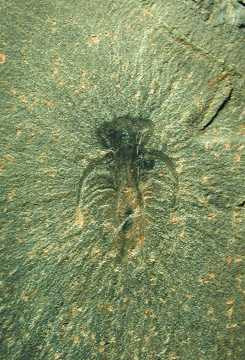 Researchers
have long suspected that ancient arthropods molted during growth, just like
modern arthropods such as lobsters and cockroaches, but until recently, such
behavior was only inferred. Now, for the first time ever, scientists have tangible
evidence that ancient arthropods shed their skins: a molting arthropod fossilized
in shale.
Researchers
have long suspected that ancient arthropods molted during growth, just like
modern arthropods such as lobsters and cockroaches, but until recently, such
behavior was only inferred. Now, for the first time ever, scientists have tangible
evidence that ancient arthropods shed their skins: a molting arthropod fossilized
in shale.Found in British Columbia, this is the first known fossil of an arthropod molting. The upper part of the arthropod is the new, soft body and the lower part is the old exoskeleton. Courtesy of Diego García-Bellido.
In 1992, a slab of rock containing the 505-million-year-old Marrella splendens fossil and five others was collected from the fossil-rich Burgess Shale in British Columbia, labeled and put in a drawer, says Diego García-Bellido, a zoologist in the Royal Ontario Museum’s department of paleobiology. Over the past few years, García-Bellido has been studying the fossil arthropod specimens in the museum’s collection.
“When I came across this specimen,” he says, “at first it just looked weird.” But upon further examination under a microscope, he began to see distinct features in two layers. The specimen is halfway through the act of molting, squeezing out of its old exoskeleton.
“It is quite remarkable,” García-Bellido says, considering the entire molting process probably lasted less than 20 minutes. To be entombed in this distinct moment in time, this arthropod must have had a “pretty fast burial,” he says, possibly by an underwater mudslide. Indeed, “what is astonishing about this discovery is its rarity,” says Derek Briggs, a paleontologist at Yale University. This fossil, described in the May 6 Nature, represents just one of more than 25,000 specimens of Marrella, he says, but it is the only one in the process of molting.
Although a surprising find, the specimen looks exactly as scientists thought it would. Like a modern cockroach, this critter cracked its exoskeleton and pulled itself out of its shell. “We knew that Marrella must molt like all other arthropods,” Briggs says, “but it had never been seen in a fossil.”

